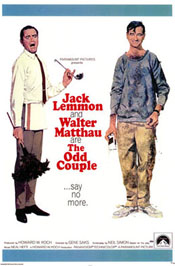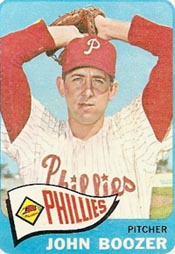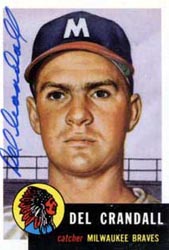|
CONTENTS
Statistical Anomalies
Staged Triple Play
Homer into Another Ballpark
Player Traded for Himself?
Kicked Out of His Very First Game?
Out with Old, In with New
One Hit Allowed in 18 Innings
From P to 1B
Ejected While Warming Up
HR Leader with 6
Odd Baseball Facts - I
Odd Baseball Facts - II
Odd Baseball Facts - IV
Odd Baseball Facts - V
Odd Baseball Facts - VI
Odd Baseball Facts - VII
Odd Baseball Facts - VIII
Odd Baseball Facts - IX
Baseball Magazine
Golden Rankings Home
Top of Page
|
Odd Baseball
Facts Archive – III
- Significantly more players hit .300 to .304 in a season than .296 to .299.
- More pitchers win 0 games than 1; more pitchers win 1 game than 2; more pitchers win 2 games than 3; and so on all the way to 30 wins with one exception: 20. Significantly more pitchers finish with 20 wins than with 19.
One reason that more batters hit just above .300 rather than just below .300 may be that managers sit a player the final game(s) of the season to preserve his .300 average.
The opposite may be true about 19-game winners. Managers give them extra chances to win their 20th as the season comes to a close, even pitching them in relief.
Reference: Baseball Research Journal, Summer 2009
This item is a debunking of an alleged Odd Baseball Fact.
Scenes from the Odd Couple movie were shot on location before and during a Mets-Pirates game at Shea Stadium on June 27, 1967.
- Felix Unger (played by Jack Lemmon) phones his roommate Oscar Madison (Walter Matthau), a sports reporter in the press box, to ask him what he would like for dinner. As a result, Madison misses seeing a game-ending triple play.
- Originally, Roberto Clemente of the Pirates was designated to hit into the staged triple play. However, he kept beating the throw to first. After several takes, Clemente ran so slowly he appeared to be walking. So Bill Mazeroski took his place and fills the dubious role in the movie. (Some sources say Clemente refused to do the triple-play scene because of pride. However, that was not the case.)
- One source says: "After the scene was shot but before the crew left the park, a triple play occurred in the real game being played as a backdrop to the scene." If true, this would certainly be an intriguing coincidence. Unfortunately, the box score for the game does not list a triple play nor was there one in the previous night's game nor the next day's game against the Phillies.
|
|
Homer into Another Ballpark
For the 1890 season, the Players League fielded a team called the New York Giants while the original Giants competed in the older National League. These were just two of the five clubs competing for fan affection in New York City that year.
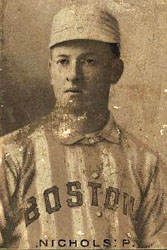 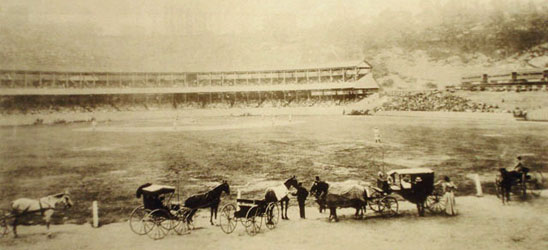 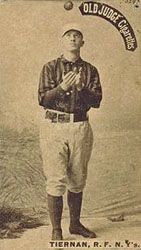 Brotherhood Park 1890, which become the Polo Grounds the next year
Brotherhood Park 1890, which become the Polo Grounds the next year
- The Players League Giants played in Brotherhood Park, which occupied the northern part of Coogan's Hollow, a flat grassy area beneath Coogan's Bluff in the Harlem section of Manhattan. The NL Giants cavorted in a smaller park called the Polo Grounds which was adjacent to Brotherhood Park in the southern part of the Hollow.
- On May 14, 1890, Mike Tiernan of the NL Giants hit a 13th-inning HR off Charles "Kid" Nichols of the Boston Beaneaters. The clout rose over the CF fence of the Polo Grounds and landed in Brotherhood Park where another game was going on. Fans in both parks cheered Tiernan as he rounded the bases.
- When the Players League folded after the 1890 season, the "real" Giants moved into the larger park a few hundred feet north and renamed it the Polo Grounds.
|
Player Traded for Himself?
This is another discussion of an Odd Baseball Fact that actually isn't as odd as usually reported. The "fact" in question is C Harry Chiti being traded for himself in 1962.
- Among many sources that could have been chosen, here is what historicbaseball.com says on its Harry Chiti page:
The New York Mets traded for Harry Chiti in exchange for a player to be named later. That player ended up being Harry Chiti. Thus, Chiti was, in a sense, traded for himself.
- Other sources say that the Mets paid another team (the Indians, but often, as in the example above, not even mentioned when discussing the transaction) for the C and promised a player to be agreed on later, which turned out to the Chiti. Thus the NL expansion team supposedly ended up short of both the money and the player they paid for. Hence, the trade is frequently cited as amusing evidence of the ineptitude of the original Mets front office and team.
Here are the facts as gleaned from newspaper articles the day after each transaction.
- On April 26, 1962, the New York Mets purchased 29-year-old journeyman C Harry Chiti from the Cleveland Indians. The AP article says "the Mets presumably paid $25,000." Chiti was not on the Cleveland roster but rather played for the Indians' AAA affiliate, Jacksonville of the International League. There is no mention of a player to be named later. The transaction was a straight purchase.
- On June 15, the Mets released the "disgruntled" Chiti back to Jacksonville after he appeared in 15 games. Harry never played in another major league game.
Conclusion: The Mets purchased a player who didn't pan out and sent him back where he came from. There is no mention of whether New York recouped its purchase price. Who knows? The Mets may not have paid Cleveland the $25,000 by the time they released Chiti. At any rate, it is inaccurate to say that Harry Chiti was traded for himself since he was sold, not traded, to the Mets with no player to be named later clause in the purchase agreement. It was not a transaction the Mets could be proud of, but it was not the epitome of ineptitude the oft-told story makes it out to be.
|
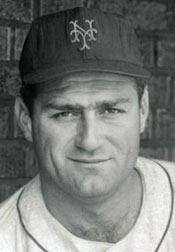
Harry Chiti
|
|
|
Kicked Out of His Very First Game?
I didn't plan on turning this space into a debunking legends feature, but I seem to have run into a string of "odd facts" that turn out not to be facts at all. This one concerns Del Crandall's major league debut. Here is one version of the story.
Crandall was ejected in the first inning of his very first major league game, while catching, by Hall of Fame umpire Jocko Conlan for arguing balls and strikes after only two pitches had been thrown and both had been called balls. According to Crandall, they were strikes, and when he questioned Jocko about them, Conlan called time out, walked around to the front of home plate, turned around to face him, took out his brush, and while wiping the plate said, "Ain't no busher gonna come up here and tell me how to call a game." Crandall told Conlan where he could "shove" his "busher" and Conlan immediately heaved him. The Boston Braves had flown his parents out for the game, and Del said he will never forget the astonished look on his mother's face as he walked past her front row seat on his way to the dugout. He states that every time he ran into Conlan thereafter, that Conlan claimed credit for "straightening him out."
Here are the facts from newspaper accounts for June/July 1949.
- 19-year old Del Crandall was called up from the Class B Evansville club on June 16, 1949,
to replace the veteran C Phil Masi who was sold for $50,000 to Pittsburgh.
- Crandall joined the Braves for the start of a series in Cincinnati. He came into the game on Friday, June 17, as a pinch runner in the ninth inning for C Bill Salkeld. Since Boston lost, he didn't get behind the plate in the bottom of the ninth.
- The box score of the June 18 game lists Crandall as the only C for the Braves. He went 0-3. So he was not ejected from the game. Also, Jocko Conlan was not a member of the NL crew working that series (Barr, Ballantine, and Barlick).
- That takes care of Crandall's first two games. What about the final day of the Cincinnati series? No, he didn't appear in either game of the doubleheader.
Could Crandall have been thrown out of his first home game with his parents in attendance?
- The Braves returned from the road trip to host the Phillies on Friday, July 1. Crandall caught the entire 12-inning game, going 2-for-5 in his Beantown debut. Again, Jocko Conlan is not listed as one of the umpires.
- How about the next day, July 2? No, Crandall caught all nine innings, as he did the next day also.
- What about the July 4 DH against the Giants? Crandall didn't appear in the first game but caught the entire second game.
Conclusion: Del Crandall may have been thrown out of a game by Jocko Conlan (or some other umpire) after only a few pitches during his rookie season (or in some other season), but it didn't happen in his first game or his first series on the road or the first series at home.
|
Out with Old, In with New
P Bennie Daniels holds the distinction of appearing in the last games played in not one but two stadiums. He also won the first game ever played in another ballpark.
- Born in 1932, Daniels was an ambidextrous P who sometimes warmed up as a lefty but threw righthanded in games.
- On September 24, 1957, he started for the visiting Pittsburgh Pirates against the Brooklyn Dodgers in the last game played in Ebbets Field. He had earned a September call-up after compiling a 17-8 record with the Hollywood Stars of the Pacific Coast League. He surrendered only five hits and one earned run in seven innings of the 2-0 loss before a meager turnout of 6,702.
- After the 1960 season, the Pirates traded Daniels to the expansion Washington Senators along with two other players for LHP Bobby Shantz.
- The Senators played the 1961 season at old Griffith Stadium while waiting for their new home to be built. Bennie went 12-11 for a team that lost 100 times.
- Daniels started the last game played at Griffith Stadium on Thursday, September 21, 1961. He took the loss to the Minnesota Twins (the franchise that was the original Washington Senators) 6-3. The crowd of 1,498 made the assemblage at the Ebbets Field farewell look massive.
- On Monday, April 9, 1962, he won the first game played at D.C. Stadium, now named RFK Stadium, beating the Detroit Tigers 4-1 on a complete game five-hitter before 44,383.
Daniels spent the rest of his career with the Senators before retiring after the 1965 season at age 33. The Washington franchise became the Texas Rangers after the 1971 season.
|
|
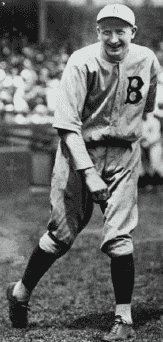
Dazzy Vance |
One Hit Allowed in 18 Innings
On September 8, 1925, Dazzy Vance of the Brooklyn Robins faced the Philadelphia Phillies at Ebbets Field in the first game of a DH.
- Vance faced only 27 batters as he shut out the Phillies 1-0.
- The lone bingle off him was a clean single to right by Chick Hawks with one out in the second. After the next batter flew out, Hawks was thrown out trying to steal second.
- Dazzy struck out six in achieving his 21st win of the season.
Five days later, Vance toed the slab against Philadelphia in the opener of another DH at Ebbets Field. (A two-game series with the New York Giants had separated the two Phillie DHs for the Robins.)
- This time, the future Hall of Famer outdid himself, yielding no hits in the 10-1 victory.
- It was the first no-hitter of Dazzy's six-year ML career to that point.
- Hawks was again the thorn in the hurler's side. This time, he scored the only Phil run on a sacrifice fly after reaching third on a two-base muff of his fly followed by a wild throw.
|
Don Newcombe had a productive career on the mound for the Brooklyn Dodgers.
- From 1949 to 1958, Big Newk won 123 games despite spending two years in the military during the Korean War.
- His 27 victories in 1956 earned the NL Cy Young and MVP Awards. He is the only P to win those two awards in addition to Rookie of the Year.
- He fell to 11 wins the following year, then was traded to the Cincinnati Reds during the '58 season. By 1961, he was out of MLB.
- Don was known as a good hitter, as his .271 batting average and 15 career HRs attest.
Newk ended his baseball career in Japan in 1962.
- Playing 1B for the Nagoya Dragons, he hit .262 with 12 HRs in 81 games.
- Newcombe ranks as the second American player to play professional baseball in Japan.
- The first was Wally Kaname Yonamine. A Nisei Japanese-American, Yonamine played RB for the San Francisco 49ers of the All-America Football Conference in 1947.
|
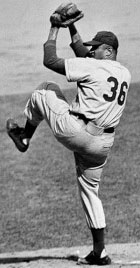
Don Newcombe |
|
On May 1, 1968, John Boozer came in to pitch for the Philadelphia Phillies against the New York Mets at Shea Stadium. But he was ejected before facing even one batter because he violated the new anti-spitball rule during his warm up.
- Manager Gene Mauch called for Boozer out of the bullpen to start the bottom of the seventh inning.
- When Boozer arrived at the mound, he wiped off some dirt from the rubber. To clean his hand, he spit on it and wiped it on his uniform.
- At that point, home plate umpire Ed Vargo called ball one on the next batter because Boozer had "gone to his mouth," which was prohibited by the new rule.
- That brought an enraged Mauch out of the dugout. While his manager argued, Boozer deliberately went to his mouth twice more while warming up. Vargo dutifully called two more balls on the next batter and ejected Boozer and Mauch.
- When Dick Hall was summoned to replace Boozer, Vargo warned him that, if he went to his mouth even once, the game would be forfeited to the Mets.
- The contest was completed without further incident.
According to the United Press International article on the game,
The rhubarb completely overshadowed the New York Mets' 3-0 victory over the Phillies and the strong, seven-inning performance by rookie Nolan Ryan,
who has the potential to become a standout pitcher.
|
 Tommy Leach |
In 1902, Tommy Leach of the Pittsburgh Pirates led the National League with only six HRs.
- Leach's six remains the lowest league-leading total since 1878.
- Furthermore, all six of Leach's HRs were inside the park.
- Tommy also led the NL in triples in 1902 with 22.
- The next season, Leach hit 7 HRs, his career high, but didn't lead the league. That distinction went to Jimmy Scheckard of the Brooklyn Superbas, who walloped all of nine four-baggers.
Both Leach's low total of six HRs and the fact that all were inside-the-park jobs are explained by the dimensions of his home field, Exposition Park.
- The distance down each foul line was 400'.
- Straight-away CF measured 450' from home plate.
- You get an idea of the immensity of the playing field from this picture.
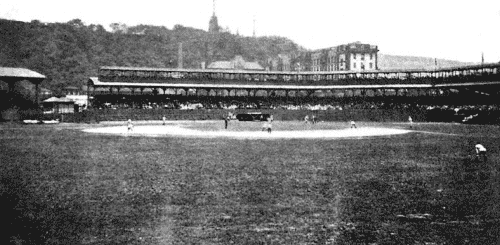
Exposition Park, home of the Pittsburgh Pirates 1890-1909 |
|
